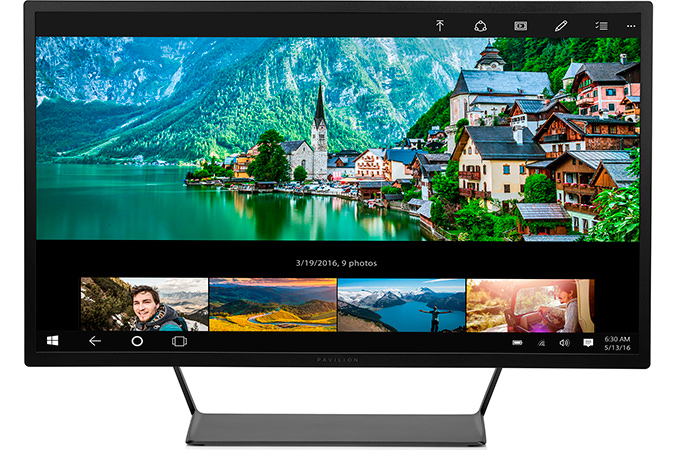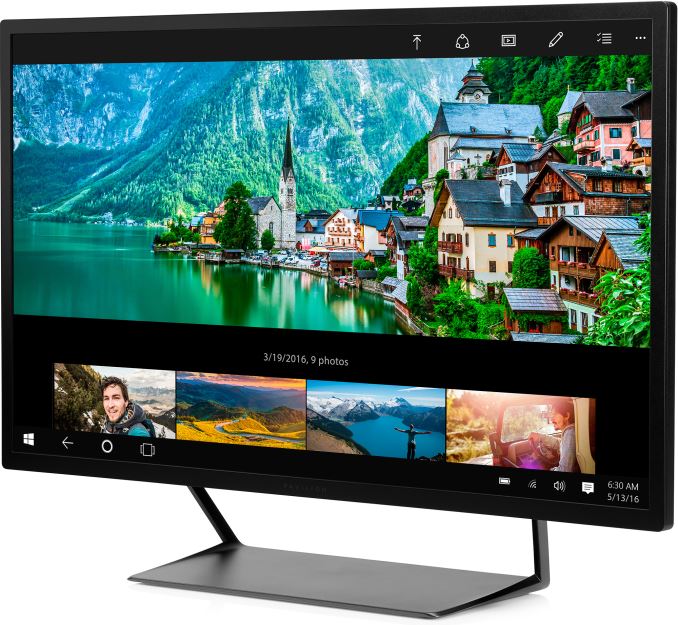HP Announces 32” Pavilion Display for Everyone: QHD for $399
by Anton Shilov on May 4, 2016 11:05 AM EST
HP has introduced its Pavilion 32 display (V1M69A), which promises to combine large size, QHD resolution, VA panel and affordability. The Pavilion 32 monitor may not appeal to professionals or hardcore gamers, but for mainstream users this one could be a game changer because of its price-point. The monitor will hit the market late next month as a part of HP’s back-to-school product refresh.
Modern day desktop workloads involve a lot of multitasking as well as long documents, large spreadsheets and high-resolution images. For many tasks, big displays are not a luxury, but rather a necessity. However, it is not easy to find a monitor that boasts with a large size, a good quality panel and an affordable price. There are relatively inexpensive 24” and 27” monitors with IPS or VA panels available, but when it comes to models with diagonals like 30” and larger, then it is not easy to find a good quality affordable display. While there are low-priced 32” monitors from unknown brands, they usually feature cheap TN panels and can hardly boast with good quality. Meanwhile, well-known suppliers charge $500 and up for their 32” models, which is more than many people are willing to spend on a display. With its Pavilion 32, HP wants to address the market of affordable monitors with an offering that is currently not available from its rivals.
The HP Pavilion 32 (V1M69A) display uses a 32" WVA+ panel with 2560×1440 resolution, 300 cd/m2 brightness, 3000:1 static contrast ratio, 178°/178° horizontal/vertical viewing angles as well as 60 Hz refresh rate. WVA stands for wide viewing angle, which is a general term to describe various types of panels (including *VA and PLS) used by display makers in their products. HP does not disclose exact type of the panel that powers the Pavilion 32”, but confirms that this is a VA panel (though, we have no idea whether this is AH-VA, A-MVA, etc.), not a TN (which is typically used for low-cost displays). In many ways, the Pavilion 32 resembles the Envy 32 monitor, which HP introduced several months ago. The Envy 32 has a similar WVA+ panel, but features stereo speakers as well as AMD’s FreeSync to appeal to gamers, but it is also more expensive.
| Specifications of HP Pavilion 32 and HP Envy 32 | ||||
| HP Pavilion 32 V1M69A |
HP Envy 32 N9C43AA |
|||
| Panel | 32" WVA+ | 32" WVA+ with Anti-Glare | ||
| Resolution | 2560 × 1440 | |||
| Refresh Rate | 60 Hz | 60 Hz with AMD FreeSync | ||
| Response Time | 7 ms gray-to-gray | |||
| Brightness | 300 cd/m² | |||
| Contrast | 3000:1 | |||
| Viewing Angles | 178°/178° horizontal/vertical | |||
| Color Saturation | 100% sRGB | |||
| Pixel Pitch | 0.276 mm | |||
| Pixel Density | 91.8 pixels per inch | |||
| Inputs | 2 × HDMI 1 × DP 1.2 |
1 × HDMI 1 × MHL 1 × DP 1.2 3.5 mm stereo-in |
||
| USB Hub | 2-port USB 2.0 hub | |||
| Audio | None | Stereo speakers with Bang & Olufsen enhancements |
||
| Launch Price | $399.99 | $499.99 | ||
The new Pavilion 32 display from HP is equipped with two HDMI and one DisplayPort 1.2 connectors (cables are included in the package). In addition, it has an integrated USB 2.0 hub, which should be enough to connect a keyboard, but which will not be sufficient for modern external USB flash memory drives that support USB 3.0 transfer rates. Keeping in mind that the hub is located on the backside of the monitor, it looks like it was not intended for removable storage in general. The design of the Pavilion 32 allows adjusting tilt, but not height. Asides from that, the monitor cannot be used in portrait mode, which is hardly a problem for the vast majority of its potential buyers.
Select retailers as well as HP’s online store will start to sell the HP Pavilion 32 on June 26 for $399.99. The monitor is covered by a one- or three year-limited warranty.
The key selling points of the HP Pavilion 32 are its relatively low price as well as its VA panel. Right now, the majority of 32” displays with QHD resolution from well-known suppliers cost over $500. By making its product available for $400, HP appeals to a broader audience of users, who currently buy smaller monitors. What remains to be seen is whether other display makers follow HP with their inexpensive 30” QHD parts.
Source: HP











74 Comments
View All Comments
Murloc - Wednesday, May 4, 2016 - link
isn't this just too big for the average viewing distance of common mortals?Yuriman - Wednesday, May 4, 2016 - link
Probably, but it's a very tempting screen for me nonetheless. I feel 27" is the sweet spot for my personal uses, but a slightly larger screen would not be a problem.javishd - Wednesday, May 4, 2016 - link
I have a little bit of a hard time with 110ppi on the 27" monitors, my vision is about 20/35. This screen might need to be scooted back a little. I would rather 30" was the norm for 1440p.kpxgq - Sunday, August 28, 2016 - link
Completely opposite here... I am using a 27" 1440p right now and wishing for a 4k 25-28". I can definitely see subpixels from 2 feet away.DanNeely - Wednesday, May 4, 2016 - link
It's 92 DPI vs 110 for a 27" 1440p monitor, or the 100 DPI that's generally used as the baseline for comparison at 1x. That makes it about 4" wider than the more common 27" variant and 2.5" taller. a 30" 1600p monitor is about the same height and midway between the two in width. I've owned one of the latter for several years and have been quite happy with it over that timespan. I keep it at about the same distance as I the 22" screens I use at work. Most non-image/map web pages only fill the middle half while showing about 50% more vertically; but for anything that can scale to full width it works wonderfully. I don't think the slightly larger width would be a problem; and the lower DPI would be a bit easier on someone with less than perfect vision or who just prefers larger text.BurntMyBacon - Wednesday, May 4, 2016 - link
@DanNeely: " That makes it about 4" wider than the more common 27" variant and 2.5" taller. a 30" 1600p monitor is about the same height and midway between the two in width."What is this 1600p you are referring to.
720p -> 1280x720
1080p -> 1920x1080
1440p -> 2560x1440
2160p -> 3840x2160 (Commonly referred to as 4K)
These whole "p" nomenclature refers to the vertical resolution of 16:9 displays. 1600p would correspond to a resolution of 2844.44x1600. I've never heard of that and wikipedia doesn't have an entry like that in their display resolution page either, so chances are fair that it isn't available for general consumption. Perhaps you were referring to the (in my opinion superior) 16:10 resolution 2560x1600. A quick wag at the calculations say that would fit your dimension description. In which case, nice find. Its hard to find a good, reasonably priced 16x10 monitor anymore (especially if you want "sync" technologies or high refresh rates). Even the newer 10bit 27" professional monitors from NEC have gone 1440p.
ann_idiot - Wednesday, May 4, 2016 - link
Typical 30" monitor is 2560X1600. That's where the 1600P is coming from.rascalion - Wednesday, May 4, 2016 - link
2560x1600 is 16:10, not 16:9. 16:9 is the ratio used with the 1080p, 1440p , etc. resolutions.Murloc - Wednesday, May 4, 2016 - link
nope, what about 480p or 360p?Go to youtube and click on the settings menu and they're all there to see.
Mondozai - Thursday, May 5, 2016 - link
That's because those are also 16:9 resolutions, dummy. All of YouTube is 16:9.